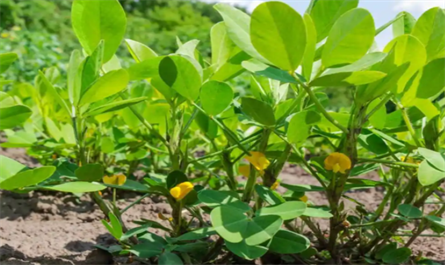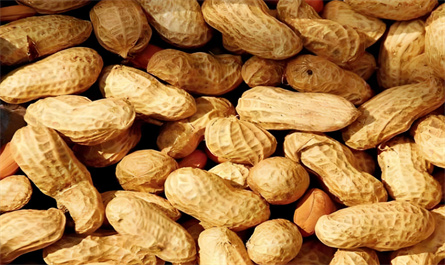What are the plant growth regulators used for peanut growth control?
During the growth of peanuts, if the vegetative growth is too vigorous, a large amount of nutrients will be consumed, resulting in insufficient nutrients for reproductive growth, affecting pod development and reducing yield. The rational use of plant growth regulators to control growth can regulate peanut growth, balance nutrient distribution, and significantly increase yield. So, what regulator is good for peanut growth control? The following is a detailed introduction.

Paclobutrazol (Paclo)
Paclobutrazol is widely used in the field of peanut growth control. It can inhibit the synthesis of gibberellins in peanuts, effectively control the elongation of stems, prevent the plant from growing too long, make the peanut plants dwarfed and compact, and enhance the ability to resist lodging. At the same time, paclobutrazol can promote the growth of peanut lateral branches, increase the chlorophyll content of leaves, improve the efficiency of photosynthesis, promote the transfer of nutrients to pods, and increase the number and fullness of pods. However, Paclobutrazol remains in the soil for a long time. If used improperly, it may affect the growth of the next crop. Therefore, the dosage must be strictly controlled when using it. According to the growth of peanuts, 30-50 grams of 15% Paclobutrazol wettable powder per acre can be used and sprayed with 30-40 kg of water.
Uniconazole
Uniconazole is also a regulator that inhibits the synthesis of gibberellins. Compared with paclobutrazol, it is more active and more effective, and has a shorter residual period in the soil and has little impact on the next crop. Uniconazole can not only effectively control the hypertrophy of peanuts, but also promote root development and enhance the stress resistance of peanuts. After the flowering period of peanuts, when the plant height reaches 30-35 cm and there is a trend of hypertrophy, 15-20 grams of 5% Uniconazole wettable powder can be used per acre and sprayed with 30 kg of water to achieve the effect of controlling hypertrophy and increasing production.

Chlormequat Chloride
Chlormequat Chloride controls the growth of the aboveground part of peanuts by inhibiting cell elongation, making the plants dwarfed and sturdy. It can enhance the photosynthesis of peanut leaves, regulate nutrient distribution, allow more nutrients to flow to pods, and improve pod quality. Chlormequat Chloride has no residue in the soil and is highly safe. When using, spray with 200-300 times of 40% Chlormequat Chloride aqueous solution during the flowering and needle-dropping period of peanuts to ensure uniform spraying and avoid excessive local dosage.
Prohexadione calcium
Prohexadione calcium can inhibit gibberellin synthesis and control vigorous growth by reducing the level of gibberellin in the plant. Unlike other regulators, it does not inhibit the apical meristem of peanuts. While controlling vigorous growth, it does not affect the reproductive growth of peanuts, and can also improve the stress resistance of peanuts and reduce the occurrence of diseases and pests. Prohexadione calcium degrades quickly in the soil and is environmentally friendly. After the flowering period of peanuts, use 10-15 ml of 5% Prohexadione calcium suspension per acre and spray it on 30 kg of water to achieve effective vigorous growth control.
When selecting peanut growth control regulators, it is necessary to comprehensively consider factors such as the regulator's characteristics, peanut growth conditions and soil conditions, and use it scientifically to achieve the ideal growth control and yield increase effects.

Paclobutrazol (Paclo)
Paclobutrazol is widely used in the field of peanut growth control. It can inhibit the synthesis of gibberellins in peanuts, effectively control the elongation of stems, prevent the plant from growing too long, make the peanut plants dwarfed and compact, and enhance the ability to resist lodging. At the same time, paclobutrazol can promote the growth of peanut lateral branches, increase the chlorophyll content of leaves, improve the efficiency of photosynthesis, promote the transfer of nutrients to pods, and increase the number and fullness of pods. However, Paclobutrazol remains in the soil for a long time. If used improperly, it may affect the growth of the next crop. Therefore, the dosage must be strictly controlled when using it. According to the growth of peanuts, 30-50 grams of 15% Paclobutrazol wettable powder per acre can be used and sprayed with 30-40 kg of water.
Uniconazole
Uniconazole is also a regulator that inhibits the synthesis of gibberellins. Compared with paclobutrazol, it is more active and more effective, and has a shorter residual period in the soil and has little impact on the next crop. Uniconazole can not only effectively control the hypertrophy of peanuts, but also promote root development and enhance the stress resistance of peanuts. After the flowering period of peanuts, when the plant height reaches 30-35 cm and there is a trend of hypertrophy, 15-20 grams of 5% Uniconazole wettable powder can be used per acre and sprayed with 30 kg of water to achieve the effect of controlling hypertrophy and increasing production.

Chlormequat Chloride
Chlormequat Chloride controls the growth of the aboveground part of peanuts by inhibiting cell elongation, making the plants dwarfed and sturdy. It can enhance the photosynthesis of peanut leaves, regulate nutrient distribution, allow more nutrients to flow to pods, and improve pod quality. Chlormequat Chloride has no residue in the soil and is highly safe. When using, spray with 200-300 times of 40% Chlormequat Chloride aqueous solution during the flowering and needle-dropping period of peanuts to ensure uniform spraying and avoid excessive local dosage.
Prohexadione calcium
Prohexadione calcium can inhibit gibberellin synthesis and control vigorous growth by reducing the level of gibberellin in the plant. Unlike other regulators, it does not inhibit the apical meristem of peanuts. While controlling vigorous growth, it does not affect the reproductive growth of peanuts, and can also improve the stress resistance of peanuts and reduce the occurrence of diseases and pests. Prohexadione calcium degrades quickly in the soil and is environmentally friendly. After the flowering period of peanuts, use 10-15 ml of 5% Prohexadione calcium suspension per acre and spray it on 30 kg of water to achieve effective vigorous growth control.
When selecting peanut growth control regulators, it is necessary to comprehensively consider factors such as the regulator's characteristics, peanut growth conditions and soil conditions, and use it scientifically to achieve the ideal growth control and yield increase effects.



